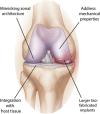From intricate to integrated: Biofabrication of articulating joints
- PMID: 28621834
- PMCID: PMC5655743
- DOI: 10.1002/jor.23602
From intricate to integrated: Biofabrication of articulating joints
Abstract
Articulating joints owe their function to the specialized architecture and the complex interplay between multiple tissues including cartilage, bone and synovium. Especially the cartilage component has limited self-healing capacity and damage often leads to the onset of osteoarthritis, eventually resulting in failure of the joint as an organ. Although in its infancy, biofabrication has emerged as a promising technology to reproduce the intricate organization of the joint, thus enabling the introduction of novel surgical treatments, regenerative therapies, and new sets of tools to enhance our understanding of joint physiology and pathology. Herein, we address the current challenges to recapitulate the complexity of articulating joints and how biofabrication could overcome them. The combination of multiple materials, biological cues and cells in a layer-by-layer fashion, can assist in reproducing both the zonal organization of cartilage and the gradual transition from resilient cartilage toward the subchondral bone in biofabricated osteochondral grafts. In this way, optimal integration of engineered constructs with the natural surrounding tissues can be obtained. Mechanical characteristics, including the smoothness and low friction that are hallmarks of the articular surface, can be tuned with multi-head or hybrid printers by controlling the spatial patterning of printed structures. Moreover, biofabrication can use digital medical images as blueprints for printing patient-specific implants. Finally, the current rapid advances in biofabrication hold significant potential for developing joint-on-a-chip models for personalized medicine and drug testing or even for the creation of implants that may be used to treat larger parts of the articulating joint. © 2017 The Authors. Journal of Orthopaedic Research Published by Wiley Periodicals, Inc. on behalf of the Orthopaedic Research Society. J Orthop Res 35:2089-2097, 2017.
Keywords: additive manufacturing; articular cartilage; bioprinting; osteochondral; regenerative medicine.
© 2017 The Authors. Journal of Orthopaedic Research Published by Wiley Periodicals, Inc.
Figures


Similar articles
-
3D Bioprinting for Cartilage and Osteochondral Tissue Engineering.Adv Healthc Mater. 2017 Nov;6(22). doi: 10.1002/adhm.201700298. Epub 2017 Aug 14. Adv Healthc Mater. 2017. PMID: 28804984 Review.
-
3D printing of fibre-reinforced cartilaginous templates for the regeneration of osteochondral defects.Acta Biomater. 2020 Sep 1;113:130-143. doi: 10.1016/j.actbio.2020.05.040. Epub 2020 Jun 4. Acta Biomater. 2020. PMID: 32505800
-
The bio in the ink: cartilage regeneration with bioprintable hydrogels and articular cartilage-derived progenitor cells.Acta Biomater. 2017 Oct 1;61:41-53. doi: 10.1016/j.actbio.2017.08.005. Epub 2017 Aug 4. Acta Biomater. 2017. PMID: 28782725 Free PMC article.
-
Converging functionality: Strategies for 3D hybrid-construct biofabrication and the role of composite biomaterials for skeletal regeneration.Acta Biomater. 2021 Sep 15;132:188-216. doi: 10.1016/j.actbio.2021.03.008. Epub 2021 Mar 10. Acta Biomater. 2021. PMID: 33713862 Review.
-
Advancement of 3D biofabrication in repairing and regeneration of cartilage defects.Biofabrication. 2025 Feb 12;17(2). doi: 10.1088/1758-5090/ada8e1. Biofabrication. 2025. PMID: 39793203 Review.
Cited by
-
Combining multi-scale 3D printing technologies to engineer reinforced hydrogel-ceramic interfaces.Biofabrication. 2020 Feb 19;12(2):025014. doi: 10.1088/1758-5090/ab69d9. Biofabrication. 2020. PMID: 31918421 Free PMC article.
-
Tissue-Engineered Grafts from Human Decellularized Extracellular Matrices: A Systematic Review and Future Perspectives.Int J Mol Sci. 2018 Dec 18;19(12):4117. doi: 10.3390/ijms19124117. Int J Mol Sci. 2018. PMID: 30567407 Free PMC article.
-
Translational Application of Microfluidics and Bioprinting for Stem Cell-Based Cartilage Repair.Stem Cells Int. 2018 Feb 20;2018:6594841. doi: 10.1155/2018/6594841. eCollection 2018. Stem Cells Int. 2018. PMID: 29535776 Free PMC article. Review.
-
3D Bioprinted Highly Elastic Hybrid Constructs for Advanced Fibrocartilaginous Tissue Regeneration.Chem Mater. 2020 Oct 13;32(19):8733-8746. doi: 10.1021/acs.chemmater.0c03556. Epub 2020 Sep 25. Chem Mater. 2020. PMID: 34295019 Free PMC article.
-
Recent Trends in Decellularized Extracellular Matrix Bioinks for 3D Printing: An Updated Review.Int J Mol Sci. 2019 Sep 18;20(18):4628. doi: 10.3390/ijms20184628. Int J Mol Sci. 2019. PMID: 31540457 Free PMC article. Review.
References
-
- Shirer M, Chute C, Kmetz K. 2016. Worldwide Semiannual 3D Printing Spending Guide [Internet]. IDC [cited 2017 Jan 31] Available from: https://www.idc.com/getdoc.jsp?containerId=prUS41671116
-
- Hornick J. 2016. 3D printing in Healthcare. J 3D Print Med 1:13–17.
-
- Krishnan SP, Dawood A, Richards R, et al. 2012. A review of rapid prototyped surgical guides for patient‐specific total knee replacement. J Bone Joint Surg Br 94:1457–1461. - PubMed
-
- Yoshikawa M, Sato R, Higashihara T, et al. 2015. Rehand: realistic electric prosthetic hand created with a 3D printer. Conf Proc IEEE Eng Med Biol Soc 2015:2470–2473. - PubMed
Publication types
MeSH terms
Grants and funding
LinkOut - more resources
Full Text Sources
Other Literature Sources

